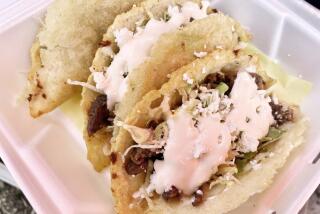Fresh Fruit : The Most Fragrant Fruit
- Share via
Few pleasures can equal standing in the green shade of a large mango tree, slurping the dripping, aromatic fruit.
For that matter, scoring a really fine mango at the grocer’s is no mean thrill. Fortunately, although mangoes have a long way to go before they’ll ever be as popular here as they are in tropical countries, they are a lot easier to find than they were just a few years ago.
Most of them still come from Mexico, Haiti and Brazil--even before Hurricane Andrew, the Florida crop provided only a fraction of the total consumed--but quality and variety are improving. That’s especially true in summer, peak season for imported and domestic mangoes.
In her book “Uncommon Fruits and Vegetables,” Elizabeth Schneider describes six of the most commonly sold varieties, noting that they are very seldom sold by name. Unfortunately there’s little chance to hold a mango tasting, comparing the relatively bland Tommy Atkins (Schneider likens it to a Delicious apple) with the complex Kent, the rich Hayden or the fibrous but pleasantly sharp Van Dyke.
Mango selection is always a gamble, since fully ripe ones are far too soft for shipping, and any mango picked too green will be a fibrous, insipid--and expensive--disappointment. But if they’re picked somewhere in the middle, mangoes will continue to ripen at room temperature, rewarding the patient shopper with juicy, sweet fruit that’s delicious eaten out of hand or used just about anywhere a peach might be good.
A taut skin is crucial to quality, but fragrance is the best indicator of lusciousness. Rich perfume is probably too much to expect, but there should be at least some appetizing aroma. While a red-blushed gold color is usually an indicator of ripeness, one of the most reliable mangoes, the Keitt, is green even when fully ripe.
Anyone who’s ever said anything about this juicy, recalcitrant fruit has at some point mentioned the bathtub. A thorough clean-up is almost a necessity--the mango’s skin clings to its flesh and the flesh clings to the pit, which is huge and often not quite where you think it’s going to be. By definition, a fully ripe mango is messy.
But since most of the mangoes sold in the United States are on the firm side, they’re fairly easy to peel and pit. For firm fruit, start by removing the skin. A sharp vegetable peeler works well. So does a paring knife.
The pit is shaped like a flattened football, its sharp edges perpendicular to the rounder axis of the fruit. Set the skinned mango stem-up and slice off each plump side about one-quarter inch away from the stem. If you hit the pit, just move outward a bit and keep going. You now have two half-rounds of fruit and a ring of flesh around the pit. This is usually the stringiest part, with only a thin rim of tender flesh around the outer edge. Cut away the tender part and scrape the juice from the fibrous area next to the pit.
If you have soft fruit, do not peel it. Begin by separating the fruit from the pit as described above. Slice it into 1/2-inch-wide strips, set skin-side down on a work surface and run a thin knife between the fruit and the skin to separate them.
*
The sharp sweetness of mango is a perfect foil for shrimp, especially when black pepper and ginger add a dash of subtle heat. The flavor is rich and the texture suave, so although there is no sauce to speak of, the mixture goes well with rice. It’s good in soft flour tortillas too.
MANGO SHRIMP 1 pound medium shrimp 1 1/2 tablespoons tamari (aged) soy 1 tablespoon dry Sherry 1 large sweet onion, such as Vidalia 1 large or 2 medium mangoes 1/3 cup cornstarch 3/4 teaspoon freshly ground black pepper 1/2 teaspoon ground ginger 1/3 cup peanut oil or corn oil 1 tablespoon lime juice Lime wedges Salt
Peel and devein shrimp, rinse and pat dry with paper towels. Combine in non-reactive bowl with tamari soy and Sherry and set aside.
Chop onion into 1/2-inch dice. Peel mango, cut flesh into 1/2-inch dice and scrape as much juice as possible from seed over cubed flesh. Set aside onion and mango.
Combine cornstarch, pepper and ginger in plastic food bag and shake to mix.
Remove shrimp from marinade, brushing off excess liquid, and add to plastic food bag. Reserve marinade. Shake bag until all shrimp are coated, then transfer shrimp to coarse strainer and toss to remove excess cornstarch.
Line baking sheet with paper towels. Add oil to large wok over high heat and heat until almost smoking. Add 1/3 of shrimp and fry, stirring with slotted spoon, about 1 minute or until just cooked. Remove and drain on prepared paper towels. Repeat until all shrimp are cooked.
Pour off and discard all but about 1 tablespoon oil, add onion and fry 1 1/2 minutes, or until translucent and just starting to brown. Return shrimp to wok, stir well, then add mango, reserved marinade and lime juice. Cook about 30 seconds more, or just until heated through. Taste and season as needed with salt. Serve at once garnished with lime wedges. Makes 4 servings.
Note : Like cashews and poison ivy, mangoes are members of the Anacardiaceae family. The juice does not bother most people, but it can severely irritate the skin of those allergic to it.
More to Read
Eat your way across L.A.
Get our weekly Tasting Notes newsletter for reviews, news and more.
You may occasionally receive promotional content from the Los Angeles Times.










